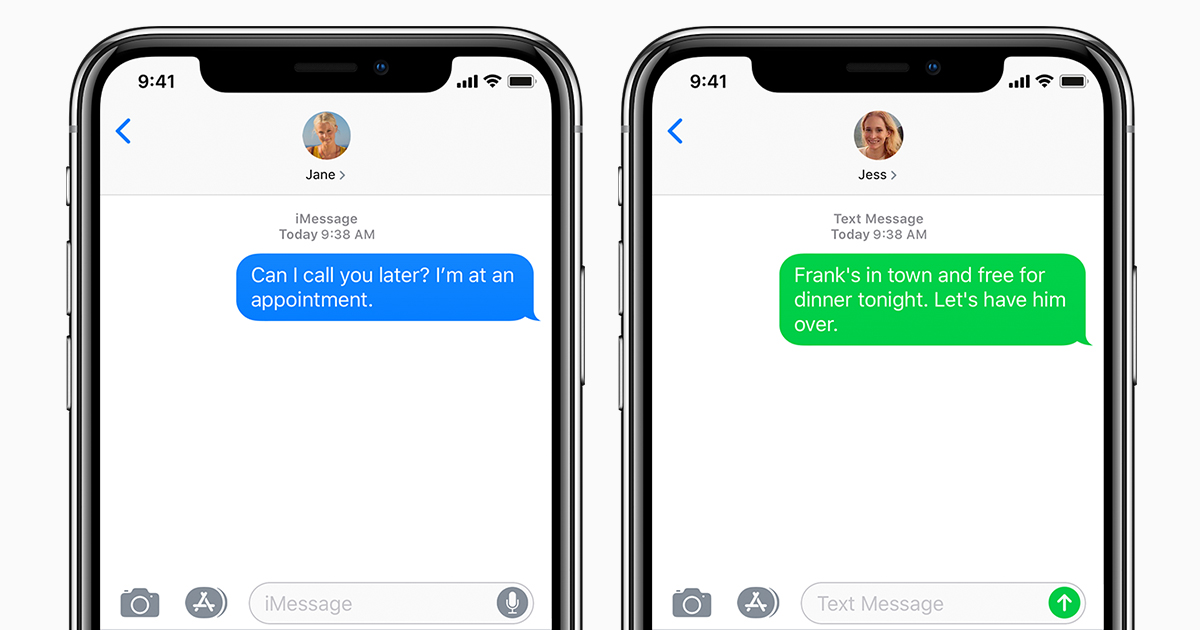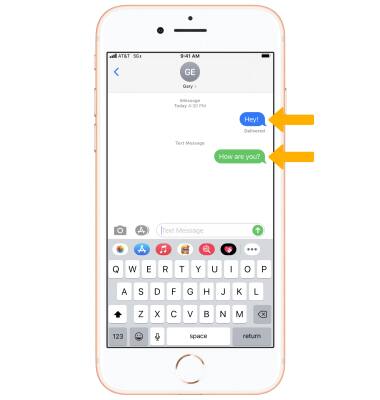There are so many different ways to send text messages today that regardless of whether you use an iPhone or an Android, you’ve probably used multiple texting applications. You’ve also probably heard of different acronyms like SMS and MMS and come across popular mobile text messaging apps like iMessage, WhatsApp, and WeChat. We discuss what each of these terms mean and the differences in the technologies powering them. In particular, we’ll cover:
In the Messages app, you can exchange text messages using SMS and MMS through your cellular service on iPhone, and with other iOS devices and Mac computers using iMessage. IMessage is an Apple service that sends messages over Wi-Fi or cellular connections to other iOS devices (with iOS 5 or later) and Mac computers (with OS X 10.8 or later). MMS - multimedia messaging service - allows you to send pictures and other media via text, as well as send longer texts. If you have a limited data plan or poor internet connection, and iMessage. IMessage, an instant messaging service developed by Apple, is supported by iOS devices such as iPhones, iPads, MacBooks, etc. Launched in 2011, iMessage uses the native Messages app on iOS devices. Unlike SMS, it requires cellular data or Wi-Fi to send and receive messages.
- How SMS and MMS differ
- Examples of OTT applications like iMessage and WhatsApp
- The differences between SMS and OTT apps
- What drives app popularity in different parts of the world
- Commercial applications of texting
SMS and MMS: What are the differences and similarities?
SMS stands for Short Message Service. Invented in the 1980s and defined in the 1985 GSM standards, it is one of the oldest texting technologies. It is also the most widespread and frequently used.
MMS stands for Multimedia Messaging Service. It was built using the same technology as SMS to allow SMS users to send multimedia content. It’s most popularly used to send pictures, but can also be used to send audio, phone contacts, and video files.

Because SMS and MMS are sent over a cellular network, they only require a wireless plan from cellular carriers to get started. Standard SMS messages are limited to 160 characters per message. If a message exceeds this limit, it is broken up into multiple segments of 160 characters each, depending on its length. Most carriers today automatically chain these messages together to ensure they arrive in the order they are sent. Unlike SMS, MMS messages do not have a standard limit. While their maximum size depends on the carrier and the device receiving the message, 300 KB is often mentioned as the largest size most carriers will reliably handle.
What are iMessage, WhatsApp, and other OTT applications?
iMessage, Whatsapp, WeChat, Facebook Messenger, and other messaging applications are often referred to as “Over The Top” (OTT) applications. They’re called this because they do not require a cellular network connection, and use IP (internet protocols) instead. To send and receive texts using these apps, your device needs to be connected to the internet, either over WiFi or via a mobile internet connection.

iMessage is exclusively available on iOS and works through the Messages app on the iPhone. While composing a text message, iOS automatically uses iMessage if it detects that the recipient’s phone number is used with an iPhone. Otherwise, it falls back to regular SMS.
To use WhatsApp, WeChat, and other OTT apps you need to download the respective application from the app store. Once installed, these apps will identify every phone number in your contact list that uses the same application and allow you to send messages and multimedia to those contacts. Some, like WhatsApp, WeChat, and Facebook Messenger can also make audio and video calls.
How do iMessage, Whatsapp, and other OTT applications differ from SMS?
Imessage Mms Cost
Because OTT applications and SMS use completely different protocols to send messages, each has different platform and network requirements. OTT applications require an internet connection while SMS needs a mobile network connection. And while OTT apps need to be downloaded from iOS or Android app stores, SMS is supported by all modern mobile phones. As a result, each has its own relative advantages and disadvantages.
SMS is a universal technology supported by every single mobile network and device today. All you need to start texting over SMS is another person’s phone number. This makes SMS a popular channel for businesses to communicate with customers because it is more immediate than email and doesn’t require any additional app downloads. OTT apps, on the other hand, are ‘walled gardens.’ Someone using WhatsApp can’t text someone else using WeChat. They both need to be using the same apps.

Imessage Mms
OTT apps are preferred over MMS for sharing multimedia files since they don’t have the same file size limitations. They also have more features like group messaging, message broadcasting, and audio and video calling. And most importantly, OTT apps are —unlike SMS— free to use.
SMS and MMS: Global Usage
As mentioned above, SMS is most popular in the US since most carriers offer plans with unlimited texting, making SMS free or nearly free to use. iMessage is a close second because of the large number of iPhone users in the country. Texting has exploded over the last decade to the point where we’re currently witnessing over 6 billion SMS messages sent daily in the US alone. Annual MMS traffic in the US increased from 57 billion to 96 billion messages from 2010 to 2013. And with no significant costs to hold them back, we’re seeing US smartphone owners aged 18 to 24 send an average of 67 texts a day.
Unlimited texting plans are less common in other parts of the world. This is the primary reason why messaging apps like WhatsApp and WeChat gained such a significant foothold in these markets. WhatsApp is by far the most popular messaging application in the world today, with more than 1 billion people using it at least once a month. Person-to-person SMS usage in countries like India and Brazil — where mobile operators rarely offer unlimited texting plans — has been largely replaced by the free-to-use WhatsApp.
Resembling WhatsApp, WeChat also needs to be installed from the app store and has similar communications capabilities. It’s extremely popular in China, having amassed almost 500 million users to date. Like WhatsApp, WeChat was able to displace SMS because it is free to use.
Commercial applications of SMS
People are spending a significant amount of time on their phones these days: the average American adult uses a mobile device nearly 3 hours every day. Since much of this time is spent texting, many businesses have correctly surmised that SMS is one of the most effective channels for businesses to reach new and existing customers.
People simply prefer to communicate with businesses by text. The higher open and response rates — 90% of all text messages are read within 3 seconds — make SMS marketing even more attractive, especially when used in the context of customer service. For example, hospitals and clinics are successfully using SMS to send alerts and appointment reminders. And e-commerce and logistics companies are using it to provide customers with delivery notifications. For routine customer service channel inquiries, many businesses rely on automated workflows and hand off more sensitive requests to human customer service agents.
Twilio is your SMS Marketing partner

Imessage Mms Size Limit
Twilio offers a comprehensive suite of developer-friendly APIs to help you easily add communications capabilities such as SMS, voice and video to your applications and mobile marketing solutions. Twilio manages the complexity of the global carrier network to provide industry-leading message deliverability, allowing you to maximize conversion. You can also easily add new features like automated response handling or new channels like voice and push notifications, allowing your marketing platform to respond to and evolve with the preferences of your audience. This way, you'll have the right conversation at the right time, every time.
Difference Between Imessage Mms Sms
Interested in learning more? Here are additional resources for your consideration.
For marketers:
For developers:
